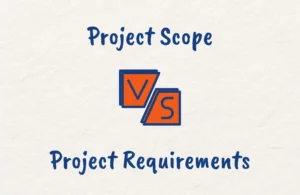Getting accurate project estimates is crucial but can be tricky. One option is using blind guesswork. With this approach though, like most things borne of blindness, you are likely to end up in a ditch.
Another option is taking a data-driven approach using parametric estimating. This technique leverages historical data and statistical analysis to predict project time, cost, and resources needed.
Learn what parametric estimating in project management is all about, how to apply it to build reliable forecasts based on quantitative variables, how it compares to other estimating techniques, and PMP certification exam tips on this technique in this post.
What is Parametric Estimating in Project Management?
Parametric estimating is a quantitative technique you can leverage to forecast project costs, timelines, and resource needs accurately using statistical analysis and historical data to calculate estimates based on established parameters and variables.
Unlike blind guesses or intuition, parametric estimating brings data-driven logic to your project forecasts by identifying statistical relationships between key project variables to predict required budgets, schedules, and other elements.
You derive the estimates using proven formulas or models based on scale factors like per unit costs. The more data you have on analogous past projects, the more precise the parametric method becomes.
Parametric estimating provides a crucial balance as it is more accurate than quick top-down estimates but faster than detailed bottom-up estimates.
This technique looks at major parameters as cost drivers without assessing every minute task and works best for projects with quantifiable elements and historical data available.

Parametric Cost Estimate
The parametric technique generates a cost estimate for your project using historical data and variable analysis.
First, you need parameters that correlate to cost, such as materials, labor hours, or equipment rental. Analyze past projects to determine costs for each parameter.
Next, define the parameters and units of measurement for your current project. This serves as the basis for cost calculation.
Then, develop a formula relating the parameters to cost. This may be simple, like cost per brick laid, or more complex incorporating multiple factors.
Finally, plug your project’s parameter values into the formula to generate the parametric cost estimate. The more historical data available, the greater the accuracy.
The estimate can be deterministic (a single definitive number), or probabilistic (a cost range based on scenarios).

Parametric Estimating Formula
The basic parametric estimating formula is:
E_Parametric = A_Old / P_Old x P_Curr
Where:
- E_Parametric = the parametric estimate
- A_Old = historical amount of cost or time
- P_Old = historical value of the parameter
- P_Curr = value of the parameter in your current project
This statistical relationship between the data variables produces your forecasted estimate.
The key is choosing parameters that strongly correlate to your estimate basis, be it cost, schedule, resources, etc.

Parametric Estimating Example
Let’s walk through an example to demonstrate parametric estimating in action.
Suppose you are estimating a project to build an e-commerce website. Based on previous website projects, your team can build 5 page templates per week.
A similar 10-page website took 2 weeks and cost $10,000 with a team of 3 developers.
For your new website with 20 pages, first, define the parameters:
- A_Old = $10,000 total cost
- P_Old = 10 pages
- P_Curr= 20 pages
Applying the formula:
- E_Parametric = $10,000 / 10 pages x 20 pages
- E_Parametric = $20,000
Therefore, the parametric cost estimate for the 20-page website is $20,000 based on the page template metric and assuming the same number of developers.
This example illustrates how the technique derives estimates by analyzing historical data relationships.

How is Parametric Estimating Used in Project Management?
Parametric estimating is a versatile technique you can apply to various aspects of project management. These include:
- Cost Estimating: Use parametric models to forecast total project costs and develop accurate budgets based on historical data. Look at cost drivers like materials and labor.
- Time Estimating: Estimate task and project duration based on analogous activities from past projects. Parameters could include work units completed per day.
- Resource Estimating: Determine required equipment, facilities, and human resources needs using parametric relationships. Define quantifiable parameters like server capacity needed.
- Early Planning: Parametric estimating is ideal in early planning when project details are uncertain. Top-down estimates lack accuracy while bottom-up is premature.
- Risk Planning: Use parametric techniques to estimate contingency reserves based on quantified risks. Historical data improves risk modeling.
- Progress Monitoring: Compare parametric estimates against actuals to monitor project performance and take corrective actions.
- Vendor Bids: Apply parametric formulas to vet vendor/contractor bids for validity. Verify cost projections match historical data.
- Estimating Ranges: Develop rough order of magnitude (ROM) estimates using parametric techniques when detailed estimating is impractical.
The key is choosing parameters that relate strongly to what you are estimating, whether that is costs, time, resources, or risks, and leveraging historical data to drive precision in your forecasts.
Advantages of Parametric Estimating in Project Management
Adopting parametric estimating offers several key advantages including:
- Accuracy: By leveraging statistical relationships derived from ample historical data, parametric estimates achieve a high degree of precision. The more relevant past data available, the greater the accuracy.
- Speed: Parametric estimating is significantly faster than granular bottom-up estimating techniques since it avoids estimating at the discrete task level. This makes it ideal for the early stages of project planning when details are uncertain.
- Scalability: The parametric formulas and models allow estimates to be scaled beyond the scope of previous projects since they quantify statistical relationships between variables. This handles large or highly complex initiatives.
- Objectivity: The data-driven parametric approach reduces bias and subjectivity compared to analogous estimating techniques that rely on expert judgment of similarities.
- Repeatability: The parametric model can be reused and tailored to your specific organization, continuously improving future estimating efforts.
- Traceability: The quantitative basis facilitates analysis of the key drivers and variables underlying the estimates.
- Stakeholder Confidence: Reliable statistical techniques provide confidence and alignment between stakeholders on project estimates.

Disadvantages of Parametric Estimating in Project Management
While parametric estimating has many benefits, there are some limitations to be aware of:
- Requires Extensive Historical Data: The technique relies heavily on having enough quality historical data to derive accurate statistical relationships. Insufficient relevant data severely reduces the precision of estimates.
- Not Ideal for some Project Elements: Parametric estimating works best for project components that are quantifiable, objective, and scalable. It may not work as well for highly subjective or creative elements.
- Regression Analysis Expertise Needed: Doing advanced parametric modeling with regression analysis requires statistical skills that some organizations lack. External expertise may be required.
- Time-consuming Initially: Developing the parametric model is an upfront investment as data must be collected, parameters tested, and formulas derived.
- Oversimplification Risk: Striving for simplicity in the model could lead to missing nuances or unique aspects of the project.
- Doesn’t Replace Bottom-up: Detailed bottom-up estimating is still required in later planning stages despite early parametric estimates.
- Hard to Estimate Intangibles: Highly subjective outcomes like customer satisfaction are difficult to model parametrically.

Analogous vs Parametric Estimating
While analogous estimating involves using past similar projects to estimate the current project, parametric estimating also relies on historical data but applies statistical analysis.
In analogous estimating, if Project A required 5 months for a specific scope, it’s estimated that Project B with a similar scope will also take 5 months. Expert judgment is relied on to determine similarity.
With parametric estimating, you analyze the relationship between scope and schedule across multiple past projects to derive a formula estimating duration based on scope. This leverages quantitative methods rather than qualitative judgment.
Analogous estimating has the advantage of being quick, intuitive, and relatively easy to implement.
Parametric estimating on the other hand has increased accuracy by leveraging statistical models, reduced bias via a data-driven approach, and allows scaling estimates beyond past data
Analogous estimating works best when you have very similar historical projects while parametric estimating can factor in differences better using statistical analysis.
For small, low-risk projects, analogous estimating may suffice when you lack significant historical data. For larger, complex projects parametric estimating provides greater precision and scalability for reliable forecasts.

Parametric vs Bottom Up Estimating
Bottom-up estimating is another project estimation technique that involves summing estimates at the task level to determine the overall project estimate, while parametric estimating focuses on key parameters derived from historical data.
In bottom-up estimating, you break down the project into discrete activities, estimate each one, and then total them up. This yields comprehensive estimates but requires detailed upfront work.
With the parametric approach, you identify variables strongly correlated to your estimate basis, like the materials needed. You analyze historical data to derive formulas between the variables and estimates.
Bottom-up estimating is very thorough since it analyzes all project tasks, and accurately reflects project scope and execution plan.
Parametric estimating is faster than granular bottom-up estimating, leverages statistical models for increased accuracy, and is simpler than assessing hundreds of minute tasks.
For small projects with limited historical data, bottom-up estimating may work better. For large projects, parametric provides the big picture view and allows scaling estimates.
Often both techniques are used together – parametric for early concept estimates and bottom-up once detailed planning occurs. This balances speed and precision over the project lifecycle.

Parametric Estimating PMP Exam Tips
Mastering parametric estimating can help you excel in the estimation questions on the PMP exam:
- Know the Inputs: Key inputs include project parameters, historical data, and expert judgment. Identify variables with the strongest correlation.
- Answer Situational Questions: If a scenario describes insufficient historical data or a unique project, parametric may not be the best fit.
- Compare Techniques: Understand when it is optimal to use parametric vs analogous estimating or bottom-up methods based on the project profile.
- Focus on Objectives: Parametric estimating aims to deliver fast, accurate, scalable, and objective estimates.
- Recall Limitations: Factor for subjectivity, complexity, creativity, and other elements not ideally suited for parametric models.
Conclusion
Parametric estimating leverages historical data and statistical analysis to generate project estimates grounded in evidence.
While requiring expertise and ample data, parametric techniques deliver vital speed, scalability, and precision when estimating projects.
FAQs
Is Parametric Estimating Top Down?
Yes, parametric estimating is a top-down estimating technique. It leverages the statistical relationship between historical data and variables (like cost and duration) to calculate an estimate.
This method is used when project activities can be quantified based on the project’s historical data.
Is Parametric Estimating Bottom Up?
No, parametric estimating is not a bottom-up estimating technique.
It’s a top-down method that uses statistical relationships and historical data to calculate estimates, applied when activities can be quantitatively determined from the project’s historical database.
Bottom-up estimating involves estimating individual task levels first.
What are the Factors that Could be Used in Parametric Estimating?
In parametric estimating, factors often used include historical data, unit cost/duration, project size, complexity, and technical parameters.
The chosen factors depend on the nature of the project and its activities. The key is having quantifiable, repeatable project elements for accurate estimations.
Parametric Estimating is Done as Part of Which Process?
Parametric estimating is typically done as part of the project “Estimate Costs” process in Project Management.
It helps in forecasting the project cost and duration, based on the statistical relationship between historical data and variables such as cost, budget, and time.





